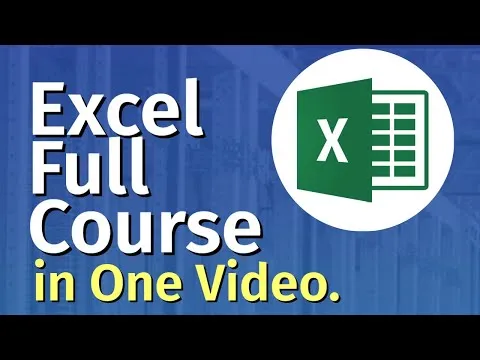
Microsoft Excel 2016 Skills and Tools Free 
Learn how to use Microsoft Excel 2016 with this free tutorial. Explore the ribbon, cells, text tools, colours, tables, shapes, filtering, and fundamental formulas like SUM and AVERAGE. Enhance your Excel skills today! ▼
ADVERTISEMENT
Course Feature
![]() Cost:
Cost:
Free
![]() Provider:
Provider:
Udemy
![]() Certificate:
Certificate:
No Information
![]() Language:
Language:
English
Course Overview
❗The content presented here is sourced directly from Udemy platform. For comprehensive course details, including enrollment information, simply click on the 'Go to class' link on our website.
Updated in [March 01st, 2023]
This free course provides an introduction to Microsoft Excel 2016. It is designed to help learners understand the fundamentals of Excel and how to use it effectively.
The course begins by introducing learners to the Excel interface, including the ribbon, cells, and text tools. Learners will learn how to make, delete, rename, and copy sheets, as well as how to insert a shape, change its colours, and apply effects to it.
Next, learners will explore how to use formulas and functions in Excel. They will learn how to use basic formulas, such as SUM, AVERAGE, and COUNT, as well as more advanced functions, such as IF and VLOOKUP.
The course then covers how to create and format tables in Excel. Learners will learn how to create a table, add and delete rows and columns, and format the table.
Finally, learners will learn how to create charts and graphs in Excel. They will learn how to create a chart, add data to it, and format it.
By the end of this course, learners will have a solid understanding of the fundamentals of Excel and how to use it effectively. They will be able to create and format tables, use formulas and functions, and create charts and graphs.
[Applications]
After completing this course, users can apply their newfound knowledge of Microsoft Excel 2016 to create and manage spreadsheets, analyze data, and create charts and graphs. They can also use the text tools and colours to create visually appealing documents. Additionally, users can use the skills they have learned to make, delete, rename, and copy sheets, as well as insert shapes, change their colours, and apply effects to them. Finally, users can use the skills they have learned to make tables and use them to organize and analyze data.
[Career Paths]
1. Data Analyst: Data Analysts use Excel to analyze data and create reports. They use formulas and functions to manipulate data, create charts and graphs, and develop predictive models. Data Analysts also use Excel to create dashboards and visualizations to help organizations make better decisions. The demand for Data Analysts is increasing as organizations become more data-driven.
2. Financial Analyst: Financial Analysts use Excel to analyze financial data and create financial models. They use formulas and functions to analyze financial statements, create budgets, and develop forecasts. Financial Analysts also use Excel to create dashboards and visualizations to help organizations make better decisions. The demand for Financial Analysts is increasing as organizations become more data-driven.
3. Business Intelligence Analyst: Business Intelligence Analysts use Excel to analyze data and create reports. They use formulas and functions to manipulate data, create charts and graphs, and develop predictive models. Business Intelligence Analysts also use Excel to create dashboards and visualizations to help organizations make better decisions. The demand for Business Intelligence Analysts is increasing as organizations become more data-driven.
4. Data Scientist: Data Scientists use Excel to analyze data and create reports. They use formulas and functions to manipulate data, create charts and graphs, and develop predictive models. Data Scientists also use Excel to create dashboards and visualizations to help organizations make better decisions. The demand for Data Scientists is increasing as organizations become more data-driven.
[Education Paths]
1. Bachelor of Science in Business Analytics: This degree path focuses on the use of data and analytics to make informed business decisions. It covers topics such as data mining, predictive analytics, and data visualization. Students learn how to use Excel to analyze data and create reports. This degree is becoming increasingly popular as businesses become more data-driven.
2. Bachelor of Science in Computer Science: This degree path focuses on the development of software applications and systems. Students learn how to use Excel to create programs and automate tasks. They also learn how to use Excel to create databases and analyze data. This degree is becoming increasingly popular as businesses become more reliant on technology.
3. Master of Science in Data Science: This degree path focuses on the use of data to solve complex problems. Students learn how to use Excel to analyze data and create models. They also learn how to use Excel to create visualizations and reports. This degree is becoming increasingly popular as businesses become more reliant on data-driven decision making.
4. Master of Science in Business Analytics: This degree path focuses on the use of data and analytics to make informed business decisions. It covers topics such as data mining, predictive analytics, and data visualization. Students learn how to use Excel to analyze data and create reports. This degree is becoming increasingly popular as businesses become more data-driven.
Course Syllabus
The Excel Basics
Tables and Shapes
Basic Formulas
Pros & Cons

Good refresher.

Detailed tutorial.

Useful for limited time.

Simple and effective.

Distracting mouse movements.

Uneven column widths.

No instructions on submitting assignments.
Course Provider

Provider Udemy's Stats at AZClass
Discussion and Reviews
0.0 (Based on 0 reviews)
Explore Similar Online Courses

Hacking Literature: How to Write Your Novel Like the Pros

YouTube Thumbnail Treasures for Social Media Marketing

Python for Informatics: Exploring Information

Social Network Analysis

Introduction to Systematic Review and Meta-Analysis

The Analytics Edge

DCO042 - Python For Informatics

Causal Diagrams: Draw Your Assumptions Before Your Conclusions

Whole genome sequencing of bacterial genomes - tools and applications

How to Make Money with Excel Right Now - Work from Home incl FREE Training

Microsoft Excel Tutorial for Beginners Excel Training FREE Online Excel course

Data Visualisation: Charting Dashboards and Pivot Tables
 Related Categories
Related Categories
 Popular Providers
Popular Providers
Quiz
 Submitted Sucessfully
Submitted Sucessfully
1. What can you learn in this course?
2. What is the main purpose of this course?
3. What software is used in this course?
4. What is the purpose of Microsoft Excel 2016 Skills and Tools Free?
Correct Answer: To learn the fundamentals of Excel.


Start your review of Microsoft Excel 2016 Skills and Tools Free